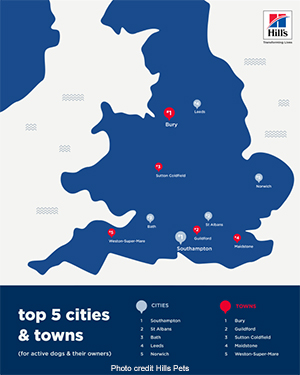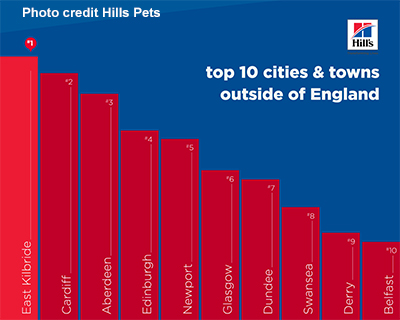Tired of leaving your best friend behind on city breaks? You're not alone! More and more dog owners are craving adventures they can share with their canine companions.
But finding truly dog-friendly destinations can be ruff! So which city breaks offer the best breaks if you’re looking for great dog walks?
Hills Pets Nutrition has crunched the numbers to find out. We've analysed 119 locations across the UK, crunching the numbers on everything from scenic trails to dog-friendly parks, to reveal the ultimate city break destinations for you and your four-legged friend. Perfect if you’re looking for the ultimate dog-walking break!
Cities were analysed on a number of dog-walk friendly factors including no. of nature and wildlife areas, proximity to National Parks, no. of picturesque trails, no. of dog parks per capita, no. of public parks and dog walk routes, elevation, crime safety, population density to avoid other walkers, and weather including sunshine hours, rainfall, and temperature. All of these factors were given weighted scores and ranked to reveal the top 10 cities, top 10 towns, and top 10 non-Uk spots.
Top 10 City Break Destinations for Dog Walkies
 Here are the top 10 cities in the UK where you and your dog can enjoy the perfect getaway with some great walks:
Here are the top 10 cities in the UK where you and your dog can enjoy the perfect getaway with some great walks:
- Southampton:
- St. Albans:
- Bath:
- Leeds:
- Norwich:
- Leicester:
- Oxford:
- Sheffield:
- Birmingham:
- Cambridge:
The top towns are Bury, Guildford, Sutton Coldfield, Maidstone and Weston-Super-Mare. The full list, including top 10 towns and non-English locations can be found here too: https://www.hillspet.co.uk/dog-care/healthcare/the-top-towns-and-cities-in-the-uk-to-keep-you-and-your-dog-fit
We spoke to Dr Hillary Pearce, a veterinarian who partners with Hills Pets, and asked her a series of questions relating to doggy fitness if you’re keen to get on more dog walks. Some of this Q&A can be found below, and the rest of the tips can be found here.
In your opinion, what are the biggest misconceptions people have about dog fitness, and what advice would you give to dispel those myths?
"I have found that people often do not realise that dogs need to be trained and conditioned up to higher levels of physical activity, just like people. Even an energetic dog can become overly fatigued and/or injured if being asked to do endurance or strenuous physical activity beyond what it is used to. Dogs want to please us and are happy to be spending time with us, so they may not always show their exhaustion or soreness in the moment. It is important to build up to higher levels of physical activity in small increments, and to pay attention to signs of fatigue and pain, allowing proper rest, just as we would when training for our own fitness. Additionally, it’s important to understand that some breeds of dogs, especially flat-faced or heavily-coated dogs, are more susceptible to heat-stress and heat-stroke. Even in temperatures that we might consider mild and pleasant, these dogs may succumb to heat-related illness, particularly if the humidity is high. Dog owners should always carry plenty of water for their dogs, and provide rest breaks in the shade as needed."
 What are your recommendations for keeping dogs safe and comfortable while exercising in different weather conditions (e.g., hot pavement, cold temperatures)?
What are your recommendations for keeping dogs safe and comfortable while exercising in different weather conditions (e.g., hot pavement, cold temperatures)?
"Always consider the weather conditions before taking your dog out for exercise! In general, while cold can be uncomfortable, heat can be deadly. Check pavement temperatures with your own hand and if uncomfortable for you, it will be too hot for your furry friend’s paws. Play indoors or on grass instead. Always carry plenty of clean, fresh water for your dog to drink and offer it often. Be sure to teach them how to drink from your preferred carrying format (bottle, bowl, etc). Flat-faced dogs are especially susceptible to heat-related illness even in temperatures we might consider pleasant, especially if the humidity level is high. Some dogs prefer not to get wet, so finding a comfortable, well-fitted jacket for them in wet or windy weather may make outdoor exercise more enjoyable. Be sure any clothing is properly fitted and does not rub under the armpits or at the waist. As always, listen to your dog’s signals. If they are hunched and shivering, they are likely uncomfortably cold."
From a veterinary perspective, what makes a city "dog-friendly" in terms of supporting an active lifestyle for dogs and their owners? What amenities or features are most important?
"From my perspective, a city is most “dog-friendly” if it has access to safe walking routes, green spaces, and accessible veterinary practices. Some cities go even further by welcoming dog-walkers and dogs into businesses like pubs. Public water access points are also a fantastic thing to have to help keep dogs and owners active safely."


